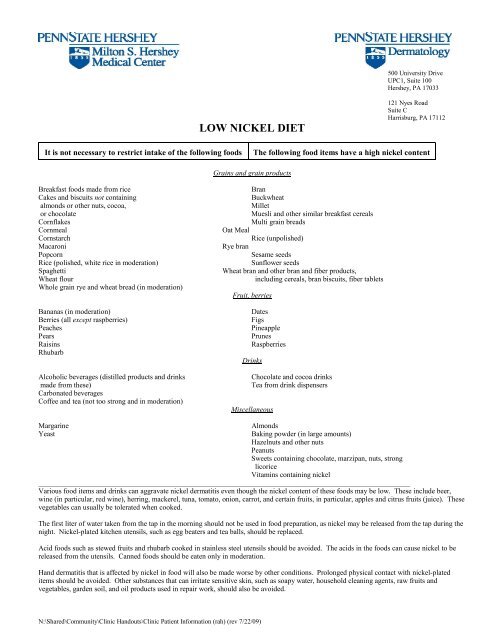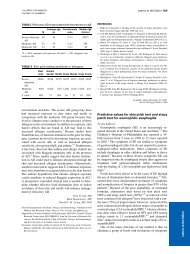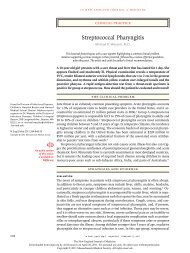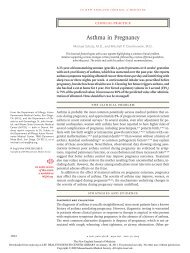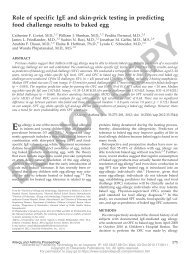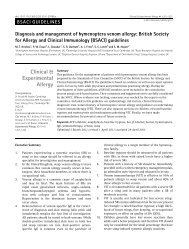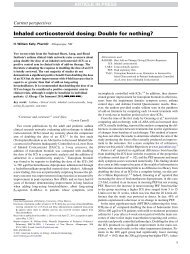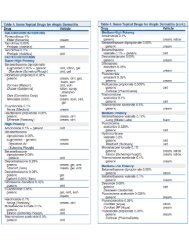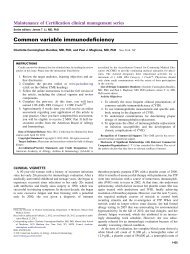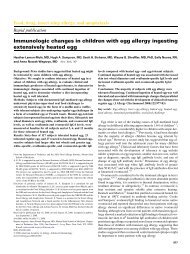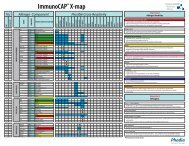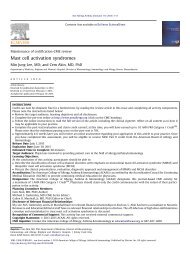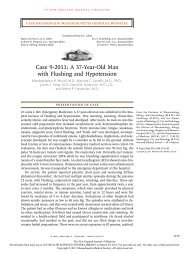Low Nickel Diets.pdf - AInotes
Low Nickel Diets.pdf - AInotes
Low Nickel Diets.pdf - AInotes
You also want an ePaper? Increase the reach of your titles
YUMPU automatically turns print PDFs into web optimized ePapers that Google loves.
500 University Drive<br />
UPC1, Suite 100<br />
Hershey, PA 17033<br />
LOW NICKEL DIET<br />
121 Nyes Road<br />
Suite C<br />
Harrisburg, PA 17112<br />
It is not necessary to restrict intake of the following foods<br />
The following food items have a high nickel content<br />
Grains and grain products<br />
Breakfast foods made from rice<br />
Cakes and biscuits not containing<br />
almonds or other nuts, cocoa,<br />
or chocolate<br />
Cornflakes<br />
Cornmeal<br />
Cornstarch<br />
Macaroni<br />
Popcorn<br />
Rice (polished, white rice in moderation)<br />
Spaghetti<br />
Wheat flour<br />
Whole grain rye and wheat bread (in moderation)<br />
Bananas (in moderation)<br />
Berries (all except raspberries)<br />
Peaches<br />
Pears<br />
Raisins<br />
Rhubarb<br />
Alcoholic beverages (distilled products and drinks<br />
made from these)<br />
Carbonated beverages<br />
Coffee and tea (not too strong and in moderation)<br />
Bran<br />
Buckwheat<br />
Millet<br />
Muesli and other similar breakfast cereals<br />
Multi grain breads<br />
Oat Meal<br />
Rice (unpolished)<br />
Rye bran<br />
Sesame seeds<br />
Sunflower seeds<br />
Wheat bran and other bran and fiber products,<br />
including cereals, bran biscuits, fiber tablets<br />
Fruit, berries<br />
Dates<br />
Figs<br />
Pineapple<br />
Prunes<br />
Raspberries<br />
Drinks<br />
Chocolate and cocoa drinks<br />
Tea from drink dispensers<br />
Miscellaneous<br />
Margarine<br />
Yeast<br />
Almonds<br />
Baking powder (in large amounts)<br />
Hazelnuts and other nuts<br />
Peanuts<br />
Sweets containing chocolate, marzipan, nuts, strong<br />
licorice<br />
Vitamins containing nickel<br />
______________________________________________________________________________________________________<br />
Various food items and drinks can aggravate nickel dermatitis even though the nickel content of these foods may be low. These include beer,<br />
wine (in particular, red wine), herring, mackerel, tuna, tomato, onion, carrot, and certain fruits, in particular, apples and citrus fruits (juice). These<br />
vegetables can usually be tolerated when cooked.<br />
The first liter of water taken from the tap in the morning should not be used in food preparation, as nickel may be released from the tap during the<br />
night. <strong>Nickel</strong>-plated kitchen utensils, such as egg beaters and tea balls, should be replaced.<br />
Acid foods such as stewed fruits and rhubarb cooked in stainless steel utensils should be avoided. The acids in the foods can cause nickel to be<br />
released from the utensils. Canned foods should be eaten only in moderation.<br />
Hand dermatitis that is affected by nickel in food will also be made worse by other conditions. Prolonged physical contact with nickel-plated<br />
items should be avoided. Other substances that can irritate sensitive skin, such as soapy water, household cleaning agents, raw fruits and<br />
vegetables, garden soil, and oil products used in repair work, should also be avoided.<br />
N:\Shared\Community\Clinic Handouts\Clinic Patient Information (rah) (rev 7/22/09)
LOW NICKEL DIET<br />
It is possible that the kind of dermatitis you have will improve if you follow a die that is low in nickel. Although nickel cannot be completely<br />
removed from the food you eat, it is possible ro reduce nickel intake by half by avoiding foods with a high nickel content. The dermatitis will<br />
probably not clear completely during the diet period, but you are likely to see fewer and shorter flares.<br />
To determine whether you can benefit from diet treatment, the diet instruction sheet must be followed carefully for 1 to 3 months. It is important<br />
not to begin the diet at a time when you anticipate travel abroad or plan to participate in many social activities.<br />
If your dermatitis clears or improves considerably after 1 to 3 months of following the diet, you can adjust the instructions as follows: Follow the<br />
diet strictly when eating at home, and adapt it to suit the circumstances when eating out. It is important to continue at all times to avoid those<br />
foods that have a very high nickel content. These include bran, oats, buckwheat, soy, legumes (in particular dried legumes, such as dried peas and<br />
beans), chocolate, cocoa, all kinds of nuts (including peanuts), and licorice. If you decide to break the diet with any of these foods, eat them in<br />
very small amounts.<br />
If you find it difficult to satisfy your appetite, it is best to supplement meals with foods containing very little nickel, for example, milk products,<br />
meat, potatoes, and cooked carrots.<br />
If after following the diet for 1 to 3 months you see no improvement in your dermatitis, the diet should be discontinued.<br />
Diet instruction for the reduction of nickel intake:<br />
It is not necessary to restrict intake of the following foods<br />
The following food items have a high nickel content<br />
Meat, fish, poultry<br />
Eggs<br />
Fish<br />
Meat (all kinds)<br />
Poultry<br />
Butter<br />
Cheese<br />
Milk in all forms<br />
Yogurt (unflavored)<br />
Shellfish like shrimp, mussels and crawfish<br />
Dairy products<br />
Chocolate milk<br />
Vegetables<br />
Asparagus<br />
Beets, red<br />
Broccoli<br />
Brussel sprouts<br />
Cabbage, white<br />
Cauliflower<br />
Chinese cabbage<br />
Corn<br />
Cucumber<br />
Dill<br />
Eggplant<br />
Garlic (in moderation)<br />
Mushrooms<br />
Onions (in moderation)<br />
Parsley<br />
Peppers, green, red<br />
Potatoes<br />
Kale<br />
Beans (green, brown, white)<br />
Leeks<br />
Lettuce<br />
Lentils<br />
Peas (green and split)<br />
Soy protein powder (used in sausages, sandwich<br />
meat, products made from minced meat, bread<br />
soup concentrates, bouillon)<br />
Spinach<br />
Sprouts made from beans and alfalfa<br />
For more information please visit our website: www.pennstatehershey.org/web/dermatology/home<br />
and click on Health Information Library.<br />
If you have any questions or concerns, please contact your provider at the location you were treated.<br />
Hershey Medical Center, UPC I, Suite 100 (717) 531-6820 or Nyes Road, (717) 657-4045.<br />
Department of Dermatology • Mail Code HU14, 500 University Drive, P.O. Box 850, Hershey, PA 17033-• Clinic Tel: (717) 531-6820 •<br />
Penn State Milton S. Hershey Medical Center • Penn State College of Medicine<br />
Clinic Fax: (717) 531-4702 • www.pennstatehershey.org/web/dermatology/home<br />
An Equal Opportunity University<br />
N:\Shared\Community\Clinic Handouts\Clinic Patient Information (rah) (rev 7/22/09)
<strong>Nickel</strong> Pyramid<br />
>50 mcg<br />
Soybean, Boiled ~ 1 cup: 895mcg<br />
Cocoa, 1 tbsp: 147 mcg<br />
Cashew, ~ 18 nuts:143 mcg<br />
Figs ~5: 85 mcg<br />
Lentils ½ cup cooked: 61 mcg<br />
Raspberry: 56 mcg<br />
20-50 mcg<br />
Vegetables, canned½ cup: 40 mcg<br />
Lobster 3 oz: 30 mcg<br />
Peas Frozen, ½ cup: 27 mcg<br />
Asparagus, 6 spears: 25 mcg<br />
Oat Flakes 2/3 cup: 25 mcg<br />
Pistachios, 47 nuts: 23 mcg<br />


